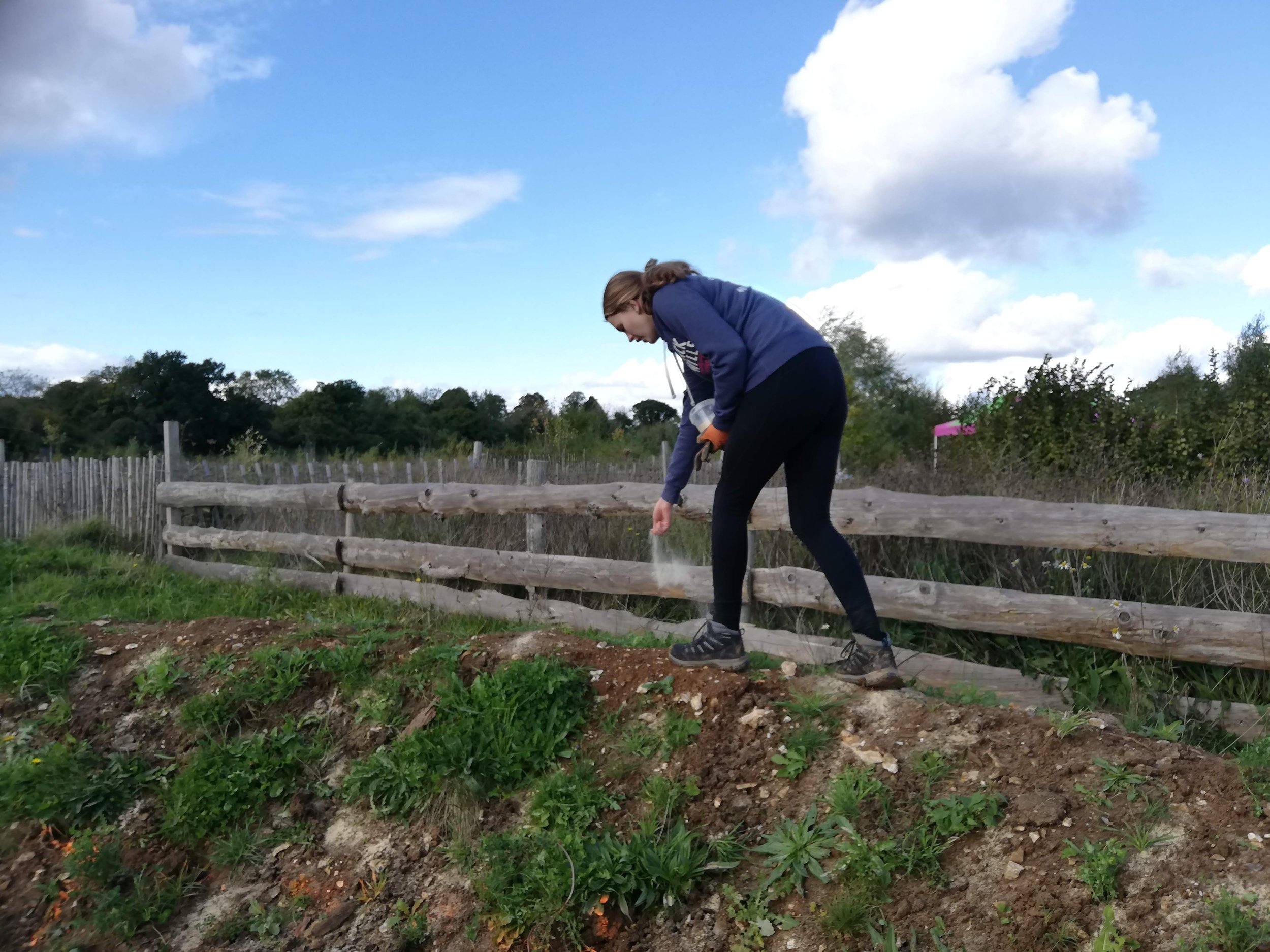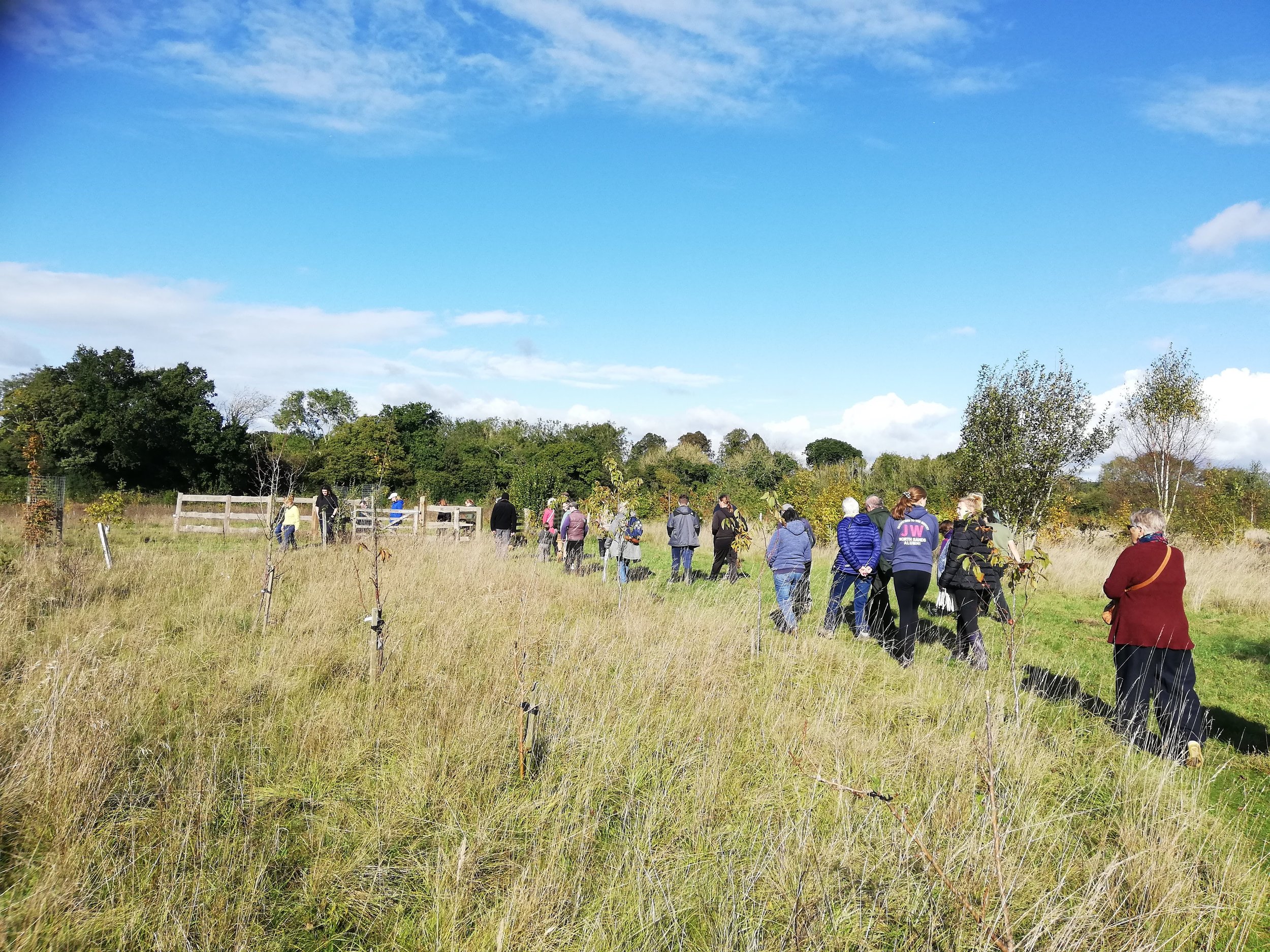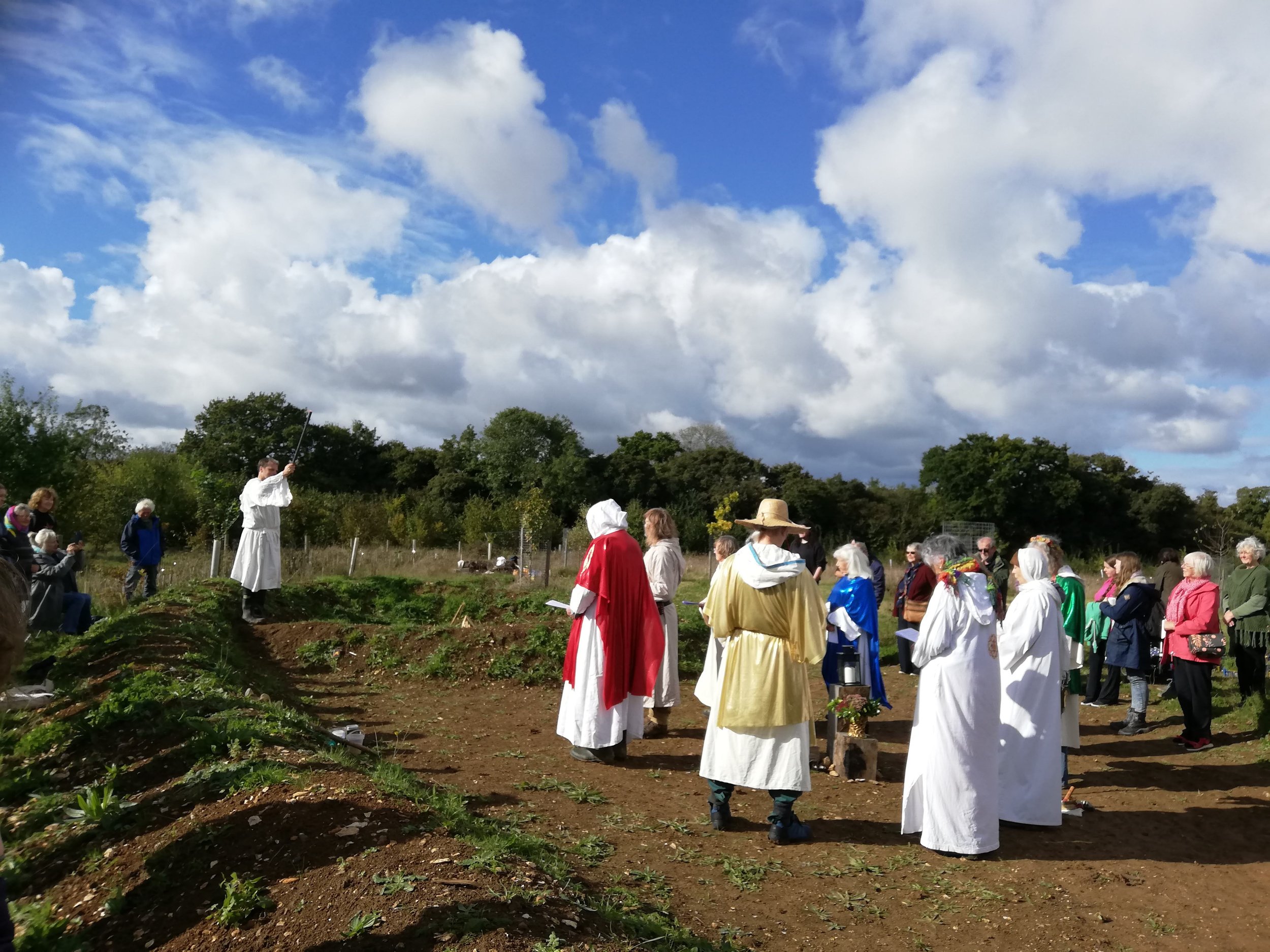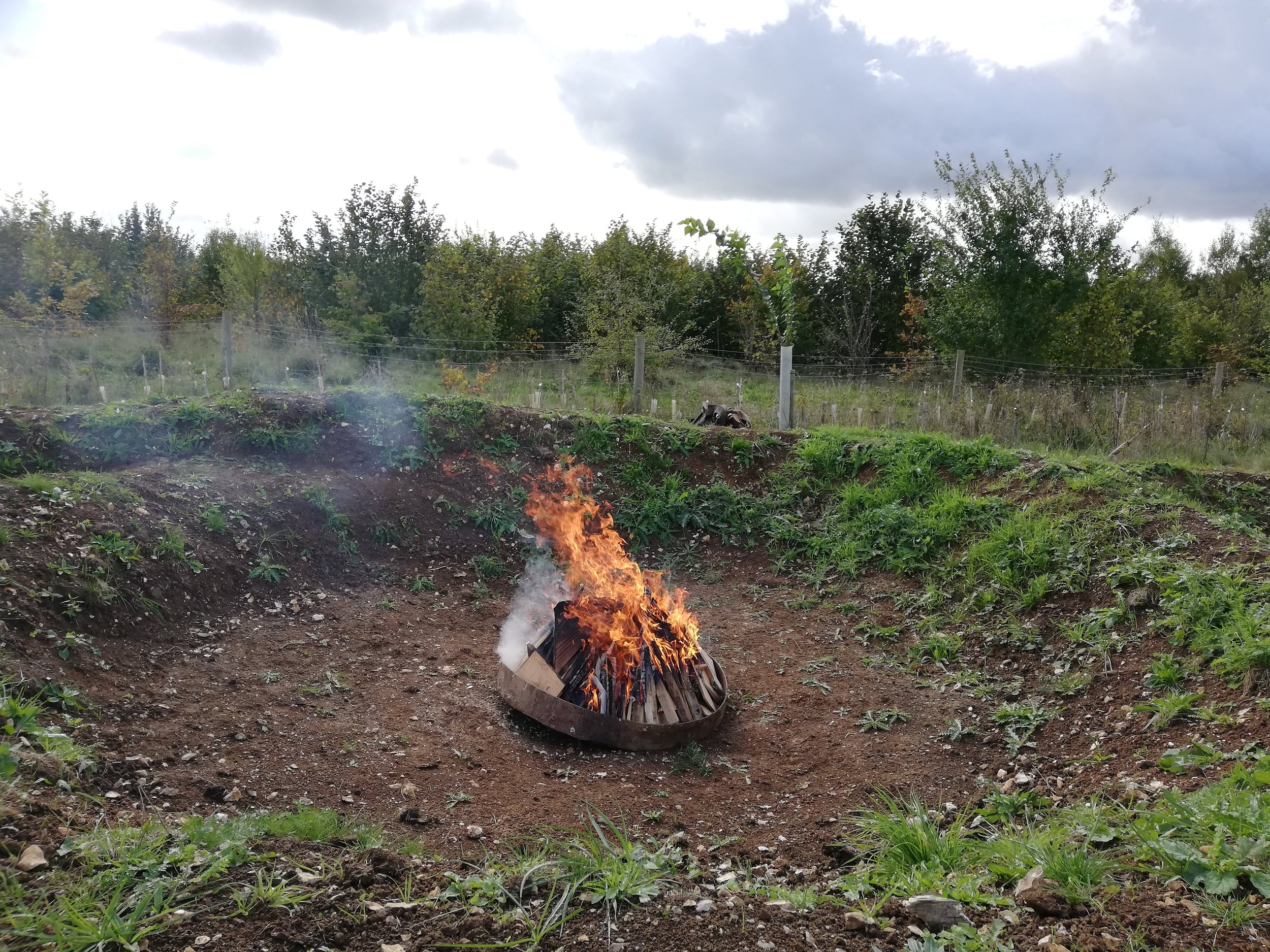Nature in Harmony Exchange Project 2023-24
Our youth team - the Nature in Harmony Exchange Project - meet on the second Saturday of each month in Harmony Woods for activities related to ecology, conservation, and woodland management.
This year the Project’s leaders are Alex and Katie (who started as the new intern in February). We are very happy to welcome previous participants Matt and Natalia who joined the Leadership Team in Janruary 2024.
Saturday 12th July 2024
July’s session was focused on surveying. The group started the session by taking part in the Big Butterfly Count. Spaced out along the habitat trail the group recorded every butterfly that they saw within 15 minutes. As expected, Marbled White’s and Meadow Browns were the main species seen, although later in the day a Ringlet and Painted Lady were spotted. Natalia also managed to spot a Small Blue, unsurprisingly next to a patch of Kidney Vetch. Read more about how you can get involved with the Big Butterfly Count here: https://bigbutterflycount.butterfly-conservation.org/
Photo by Abbey Sadler
The group then moved onto surveying Conservation Corner. Conservation corner has been an area of the woods that the group have been focused on, to create a diverse wildflower meadow that has minimal/controlled levels of disturbance. Part of Conservation Corner is now going to be transformed into a new forest school area. One aspect that the corner needed before it could be used was an area where the school can sit and discuss.
To find a section of Conservation Corner that would be suitable for this, the group decided to use quadrats to survey the area. It was agreed the area chosen shouldn’t have important food source plants, such as Kidney Vetch, and be an area of lower biodiversity, or contain plants that are in high abundance, such as Wild Carrot. The surveys will also allow for the creation of an environmental plan to mitigate the school’s impact.
Conservation Corner was split into four sections, with each person randomly placing a quadrat in each section and surveying the plants inside. Each quadrat is made up of 25 squares. When a species is identified within a quadrat the number of squares it appears in is counted, which is used to calculate the biodiversity of the quadrat, which is used as an estimate of the biodiversity in the surrounding area. Read more about quadrats here: https://www.nhbs.com/blog/how-to-use-a-quadrat#:~:text=Quadrats%20are%20used%20to%20survey,species%20present%20in%20an%20area.
Everyone did a great job! As suspected the main species found were Wild Carrot and Thistle.
The group took a break from Conservation Corner to participate in a Nature Overheard survey, dedicated to understanding how noise pollution impacts insect activity. To do this, the group walked to Enham and chose a 10x2m strip of grass next to the main road. They recorded the road sounds for five minutes before walking up and down the strip identifying the different insects and taking pictures of the different insect groups. Read more about the Nature Overheard Urban Nature project here: https://www.nhm.ac.uk/take-part/monitor-and-encourage-nature/nature-overheard/nature-overheard-survey.html
The final order of the day was moving log rounds from the cabin down to Conservation Corner, to create the discussion area for the forest school. With the far side of Conservation Corner being deemed the least diverse, the group placed the logs into a circle pattern, ready for the Saturday work team to come and strim the area.
Photo by Abbey Sadler
Friday 7th June/ Saturday 8th June 2024
This month’s session coincided with two of our most exciting Citizen Science sessions, which were made all the more exciting by our annual camp out up at the woods. The session focused on Bat and Moth identification, with the team helping our ecology intern, Katie, lead a bat walk and moth trapping session for members of the public.
Before the bat walk began the group pitched their tents in the hazel circle and set about creating a campfire, that would be used to cook dinner. Matt and Natalia were in charge of fire safety, making sure that it was far enough away from the tents, and making sure there was a bucket of water and fire gloves at the ready.
Whilst Natalia and Alex stayed behind to keep an eye on the fire and cook dinner, the rest of the group greeted members of the public for the bat walk. Before letting those who were taking part in the bat walk loose with the bat detectors, Katie first ran through some interesting facts about British bats, and what to do if you find one in your home or in distress.
The group were then let loose with the bat detectors! Bat detectors work by converting the frequency of the bat's echolocation into a frequency that humans can hear. Different bat species use different frequencies so this is used to roughly determine what species are being heard. (Read more about bat detectors here: https://www.bats.org.uk/about-bats/bat-detectors-1/bat-detectors)
After searching around the woods the group finally managed to locate some bats at Conservation Corner. Due to the frequency at which the bat detectors were set, we suspected that the bats were Common Pipistrelle (Pipistrellus pipistrellus)
Once back at camp the group first helped Katie set up the moth trap, which would be left out overnight, before tucking into jacket potatoes, as well as toasting marshmallows on the fire.
In the morning, the results of the moth trap were revealed. A range of species were found, including a Heart and Dart, Buff Ermine and Common Wave. The highlight of the trap was the first Small Elephant Hawk Moth (Deilephila porcellus) caught at the woods, a beautiful pink and yellow moth.
The group took down the tents and safely took apart the campfire, before preparing to take part in the King’s Big Help Out (Read more about the Big Help Out here: https://www.andovertrees.org.uk/news-list/big-help-out )
Saturday 9th March 2024
For this month’s session the group had wanted to plant a Scot’s Pine tree as they have done each March for the last two years, but unfortunately it wasn’t possible to purchase one so this has been postponed until the start of next tree-planting season in November. Instead the session focused on something new: learning to identify some edible plants that can be foraged.
Firstly the leaders emphasised a couple of basic rules about foraging: do not pick anything you are not 100% certain it is safe to touch and eat (check before picking, not after), and only pick enough that you will use for personal use. Always leave enough for other people to pick as well and - more importantly - leave enough for wildlife, too, as they need it more than we do. A general rule of thumb is that if there is five of something, pick one and leave the rest. (Read more at https://www.woodlandtrust.org.uk/visiting-woods/things-to-do/foraging/.)
It is still very early in the year but the group found some species that would be able to be foraged later in the year, including dandelion, ribwort plantain, oxeye daisy, hawthorn, cleavers, nettles, hazel (nuts), and dog rose (rosehips).
After this the group went to an area where they had spotted several tree guards and canes littering the ground around a double-row of young saplings that will one day become a hedge, and put them back where they should be around the young trees, to protect them from being nibbled by rabbits and deer. They then did a fantastic job at litter-picking, filling up a whole bucket from just one small area. Very well done!
The Nature in Harmony Exchange Project participants will be soon be starting to raise funds for two things: for a conservation expedition in 2025 (in 2022 the group went to Corcovado in Costa Rica), and for a pot of money they can use for Project activities, for example a Scot’s Pine to plant next winter, and litter-picking equipment. If you would like to donate, or could help with their fundraising efforts in any other way, contact alex.marshall@andovertrees.org.uk.
Saturday 10th February 2024
After assessing the Pinch Point and Conservation Corner in the January session, the team spent this month’s session planting trees at the Pinch Point. They also trimmed the long grasses around the bases of the young trees already there, to reduce competition for water and nutrients. They also decided to find a few hedgerow species to include, and hope to continue planting there in the next session.
This habitat improvement work contributes to the John Muir Award.
The Pinch Point is a wide grassy ride in the woodland that the youth team have been planting with trees and hedgerow in order to create a more narrow pathway. This is so that wildlife such as small mammals can more easily migrate into Harmony Woods from the neighbouring farmland. From the point of view of a field mouse, crossing the wide grassy path is currently like crossing the M25!
Conservation Corner is another grassy area that the youth team are maintaining for wildflowers. The grass grows on clay-capped chalk, so has the potential to be as diverse as nearby chalk meadows such as on Salisbury Plain. Chalk meadows are said to be as biodiverse as a tropical rainforest, and are one of the UKs rarest habitats.
Saturday 13th January 2024
Lily: I thought this session was really good as we talked about how to maintain some of the woods which I think is really important to do.
Natalia: We went over to the Pinch Point and Conservation Corner to come up with management plan ideas for both, before taking a walk around the entire site.
For our first session of 2024 we were joined by prospective new intern Katie and new volunteer helper Sam. The focus of the morning was to start thinking about the John Muir Award, for which the group have to look after an area of habitat. In previous years NIHEP participants created two habitat areas: the Pinch Point, and Conservation Corner. The group decided that this year’s habitat project would be to create maintenance plans for these areas so that they can be looked after in the years to come.
Laura explained that habitat management plans are important because many of the ‘natural’ places we see in the UK are actually semi-natural: natural processes happen to an extent, but human management is needed to keep them from developing into woodland in a process known as ecological succession. If the Conservation Corner, currently an area of grassland bordered by hazel trees in a corner of the site, was not managed, it would gradually turn from grassland dominated by competitive plants like thistle, to shrub, to woodland. The group would like to make it into a wildflower meadow, and started discussing ideas on how to achieve this.
Next the group took a walk around the whole of the site, so Katie could see it and she and Sam could get to know the group a bit. To encourage everyone to engage their sense of sight and pay attention to detail, Alex set a challenge of finding a female hazel flower on the way round - tiny red specks that are difficult to spot! She wondered if it might be too early still, but some were spotted! Look out for them on the tips of the buds of hazel trees. It was a very cold day so the group finished the session by warming up with a game of Bat & Moth.
Saturday 9th December 2023
Matt: At our December session we did a couple of things to build on our knowledge as well as consolidating what we already know. We did some winter tree identification and then we spoke about different mammals that may call Harmony Woods home. Once we had agreed on locations we placed out two wildlife cameras before discussing plans for our next expedition. To finish our session as a youth group we went and had a look around the nearly-finished Cabin on it’s Open Day.
After starting this month’s session with an ‘engaging senses’ silent walk around the woods - focusing on what they can see, hear, and smell - the group practised their winter tree ID. Working in pairs, they went around putting laminated labels on trees around the wood, and then went round together as a whole group with the leaders seeing whether they were correct.
The main activity of the session revolved around mammals. The group were taught some basic background information, such as the definition of a mammal, the major taxonomic groups of mammals, and key characteristics. They discussed what mammals might be present in Harmony Woods, and decided on two locations to set up motion-sensor wildlife cameras.
While setting one up, the group were excited to spot some large mushrooms almost hidden in the tangles of long grass, which were later identified as Pestle Puffballs.
For the last half hour of the session, Alex spoke to the group about the 2025 NIHEP Expedition, asking who definitely wanted to go, discussing options for destination, and arranging further meetings outside of session time for planning the trip. In summer 2022 several members of the group visited Costa Rica, where they met and worked with their exchange counterparts in the Corcovado Foundation.
Unfortunately one of the wildlife cameras did not work, but the other captured a few creatures. Look carefully in the photos below to see what you can spot, some are easier than others…
Saturday 11th November 2023
Tree identification skills and tree planting are a key part of the Exchange Project and the two awards participants work towards. To mark the start of tree planting season, which runs between November and February, this session focused on these skills. The leaders explained why we plant trees when we do: winter is when the trees are dormant, so moving saplings from the nursery to a new environment at this time is less of a shock to the young plants than when they are actively growing, giving them the best chance to survive. The group then split into pairs to walk around Harmony Woods and practice their ID, finishing at the Scots Pines (Pinus sylvestris) they planted in March 2022 and March 2023. Once there, the leaders had a surprise activity for the group - to record the announcement video for some very special, but secret, news…
After marking Armistice Day with a 2-minute silence at 11am, the group spent the remaining hour of the session planting saplings for a hedgerow, alongside the Second Saturday Community Workday team.
Matt: For the November NIHEP we checked on our Scots Pine trees. We planted one of these to mark each year of the running of our the Project. We then filmed an announcement video for something very exciting which at the time had to be kept secret, but we can now say that Andover Trees United has been awarded The King’s Award for Voluntary Service. This is the biggest award a charity in the UK can receive so we are all overjoyed. After this we went to plant some new trees, and I even helped to teach a young family how we do it.
Lily: The November session was really good as I am now more confident in tree identification and it was fun to announce the award.
Saturday 14th October 2023
For the first session of the new academic year, the leaders decided to go over some basic ecological theory with the group. The weather was good, sunny and mild, so we walked around Harmony Woods, pausing in places to go over a range of key terms and concepts.
Lily: The October session was really interesting to learn some theory which improved my understanding of nature whilst we walked around, I enjoyed it a lot.
Kitty: To start off we walked around the woods talking about the theory side of nature. After walking we headed back and watched the Druid ceremony [for the dedication of the new Dragon Garden]. Once that was finished there was a storytelling about the legendary dragon that lived [in the nearby village of Wherwell] and there was lunch and cake. To finish the day we planted wildflowers around the Dragon Garden.
Matt: At this month’s Exchange Project session we took a bit of a different route to what we normally do. Laura and Alex worked together to teach us about the basic terms within ecology and biodiversity. After this we had a Druid ceremony to open the new Dragon Garden that has been designed by one of our Trustees and formed by volunteers of the charity. The garden is in memory of a late friend of the charity.
The session finished earlier than usual as there was a special community event going on, which most of the group stayed to attend: the celebration of the Dragon Garden, the new landscaped garden on the edge of Harmony Woods. It included a Druid ceremony, storytelling, and wildflower planting. You can read about the event here: www.andovertrees.org.uk/news-list/2023/10/dragon-garden-dedication.
























